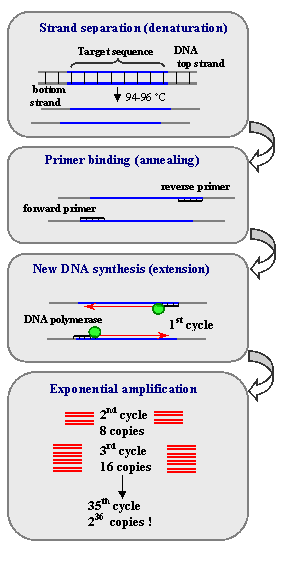Polymerase Chain Reaction (PCR)
Introduction
PCR (Polymerase Chain Reaction)
is a revolutionary method developed by Kary Mullis in the 1980s. PCR is based on using the ability of DNA polymerase to synthesize new strand of DNA complementary to the offered template strand. Because DNA polymerase can add a nucleotide only onto a preexisting 3'-OH group, it needs a primer to which it can add the first nucleotide. This requirement makes it possible to delineate a specific region of template sequence that the researcher wants to amplify. At the end of the PCR reaction, the specific sequence will be accumulated in billions of copies (amplicons).
How It Works

|
Components of PCRDNA template- the sample DNA that contains the target sequence. At the beginning of the reaction, high temperature is applied to the original double-stranded DNA molecule to separate the strands from each other.DNA polymerase- a type of enzyme that synthesizes new strands of DNA complementary to the target sequence. The first and most commonly used of these enzymes isTaqDNA polymerase (fromThermis aquaticus), whereasPfuDNA polymerase (fromPyrococcus furiosus) is used widely because of its higher fidelity when copying DNA. Although these enzymes are subtly different, they both have two capabilities that make them suitable for PCR: 1) they can generate new strands of DNA using a DNA template and primers, and 2) they are heat resistant.Primers- short pieces of single-stranded DNA that are complementary to the target sequence. The polymerase begins synthesizing new DNA from the end of the primer.Nucleotides (dNTPs or deoxynucleotide triphosphates)- single units of the bases A, T, G, and C, which are essentially "building blocks" for new DNA strands.RT-PCR(Reverse Transcription PCR) is PCR preceded with conversion of sample RNA into cDNA with enzymereverse transcriptase.Limitations of PCR and RT-PCRThe PCR reaction starts to generate copies of the target sequence exponentially. Only during the exponential phase of the PCR reaction is it possible to extrapolate back to determine the starting quantity of the target sequence contained in the sample. Because of inhibitors of the polymerase reaction found in the sample, reagent limitation, accumulation of pyrophosphate molecules, and self-annealing of the accumulating product, the PCR reaction eventually ceases to amplify target sequence at an exponential rate and a "plateau effect" occurs, making the end point quantification of PCR products unreliable. This is the attribute of PCR that makesReal-Time Quantitative RT-PCRso necessary. |
Sample Queries
Resources
» "Polymerase Chain Reaction"[MAJR]
Note: [MAJR] is a Medical Subject Heading (MeSH) tag for Major Heading. The tag is used to limit the search to articles for which major subjects are represented by terms included in the NLM MeSH database.

|

|
